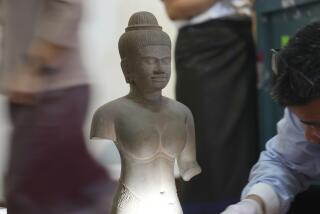Raising Statues, and a Nation
- Share via
Two magnificent statues of Buddha towered over the Afghan town of Bamian for about 1,600 years, testifying to an earlier culture, a different religion. Last year the fanatical Taliban rulers, insisting they were heeding an Islamic code forbidding idols, destroyed the icons. Now the interim ruler of the shattered nation has promised to rebuild them. The ancient statues are irreplaceable, but the effort is an important gesture about the transformation of Afghanistan.
Prime Minister Hamid Karzai said his administration had contacted the United Nations to discuss rebuilding the statues, one 175 feet tall, the other 120 feet. Who will pay is an important question. More than two decades of war, starting with the Soviet invasion of 1979, devastated an already impoverished nation. Countries like Thailand and Sri Lanka, where Buddhism is an important faith, could be donors, though given their economies their funding probably would not be substantive. Western nations pledged to religious freedom and pluralism also should be willing donors.
The Afghan sculptor picked for the job, a man who returned from exile in New York, said perhaps only one Buddha will be rebuilt, with remnants of the other left as a monument to Taliban barbarism. That would be fitting. Numerous Muslim nations protested that the destruction was not required by Islam, which forbids worship of idols but does not demand their destruction. Afghanistan of course first needs to rebuild schools and factories, shops and hospitals. The Bamian statues cannot be replicated, but even a symbolic reminder can help heal war’s scars.
More to Read
Sign up for Essential California
The most important California stories and recommendations in your inbox every morning.
You may occasionally receive promotional content from the Los Angeles Times.












